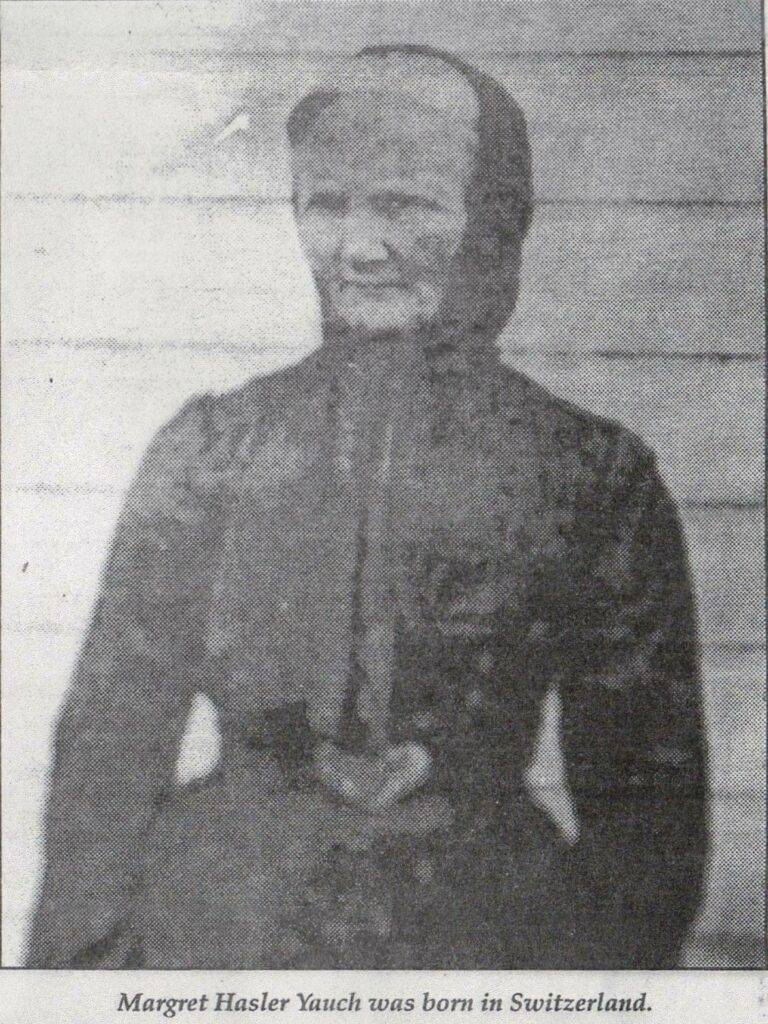
Most of us know the inscription on the Statue of Liberty which stands in New York harbor. Today we are even more aware of it than ever before Although my ancestors came here before the Statue was given to America by France the words seemed so fitting for them also.
The names Hasle, Hash, and Hasla have existed since earliest times in different cantons of Switzerland. Today there are several towns by that name. One of the oldest sections by that name is the well-known “Hasli-Thal” or Valley of Hasle. It begins near Brienz in the canton of Bern.

For centuries individuals were distinguished by their Christian or first names but as time went on, men had to add a surname or last name due to population growth. Early people of the Hasie Valley area took on the last name of “Hasle” which be came Hasler and sometimes Hassler.’ It is possible these people of Hasle Valley were considered a group or clan.
Not all from area took on the name of Hasler – some preferred names according to their occupation or locality such as ‘Carpenter’ or ‘Hill’.
The Haslers were an independent people until 1311 when they lost their independence. King Henry VII of Luxemburg demanded taxes from the Haslers to be paid to the Lords of Weissenburg. When the tax was demanded and their right to govern themselves taken away they fled to America.
My first record of the Hasler family from which my Mother descended was at Bonigen, Switzerland in the Canton of Bern.
My fourth great grandfather, Jakob (1756-1799) married Margaritha Feutz (1755-1817) in 1775, Among their six children was my third great grandfather, Kasper Hasler (1790-1849) who married Anna Studer (1793-1876) in 1812. Their fourth son, Christian, was born in 1825 in Switzerland and came to America in 1851 at the age of 26, but before I tell more about him, I want to relate to you a story of his brother, Kasper (later changed to Casper in America).
Casper was married to Katherine Moser in 1837 in Switzerland and had had strong desire to come to America for some time. They had nine children born to them while still in that country namely; twins, Rudolph and Mary Elizabeth 1838, Louisa 1839, Rudolph 1841 (the first Rudolph had died), Marianne 1842, Ferdinand 1844, Caroline 1846 (lived one year), and twins Karl Kasper and Karoline 1849.
Casper and Caroline decided to come to America which they felt was the vast land of opportunity, but since Caroline was expecting their eighth child, Casper decided to come alone and send for his family later.
To make the forty-eight day trip, he brought with him only a small barrel of cheese and crackers for eating. When he reached the shores of America, he made his way to Green County, Indiana where he had a friend by the name of Kendrick . He settled on a farm near Rockwood in 1849 and soon learned to speak English, already being fluent in French and Dutch.

Casper was a stonemason by trade. He cut and laid the stones for what was probably the first bank in Greene Co., “Downings Bank of Indiana”, located at Furnace. Furnace was a thriving town built upon the iron smelting business. Eventually when the iron industry dwindled at Furnace, the bank was torn down and moved to Bloomfield. Casper took the money earned from the original bank contract and sent it to his wife to pay her and the children’s passage to America.
Catherine and her seven children landed in New York and traveled down the rivers to Louisville, then came by covered wagon drawn by oxen to Mineral. Casper heard there was a Dutch family camped nearby, whom nobody could understand. Speaking what he thought might be their language, he went to see if he could help. To his surprise it was his wife and children. Casper was also amazed to learn that the baby Caroline had been expecting when he left, had been a second set of twins. The couple went on to have yet a third set of twins, John and Roseann, bom in 1851 and sons, Amend in 1856, William in 1858, and Edward in 1864.
Christian, a brother to Kasper, came to America in 1851 at the age of 26, He was married to Elizabeth Kumer/Konner while still in Switzerland and their first two children, Elizabeth and Margret were bom there. They would have 8 more children after coming to America. They were Christian, Albert, Adolph, Lucilia, Cornelia (died young), Jasper, Henry, and Dellah.
They were a very hard-working industrious group of people who, like most people of that day, made their living by farming.
Christian and his family lived for a very brief time in Greene Co., IN and would soon come to settle in Richland Co., IL in
Claremont Township.
He became a naturalized citizen in 1863.
Elizabeth died in 1872 at the age of 46 is buried in Brian Cemetery in Claremont Township. Christin then married Catherin Saul Shriner in 1874. Christian died in 1894 at the age of 69 and Catherine in 1911. Both are buried in Brian Cemetery.
Margret Hasler, 2nd daughter of Christian and Elizabeth, is my great-grandmother and was married to Jacob Yauch or Jauch, as it was originally spelled. He was a young German from Wurtemburg who came to America in 1858 and served in the Civil War with Company D, 108th Ohio Inf. They lived mostly in Richland Co. and to their union were born eight children. One of their children, Della, my grandmother, married Oscar Wease.
There are a great number of Hasler descendants still living in the area today. All due to an ancestor who came to America seeking freedom and Liberty.
Until Next Time…………Rena Lents Thomas
(Rena Lents Thomas (1940-2021), Clay County Republican, Louisville, Illinois, November 29, 2001)